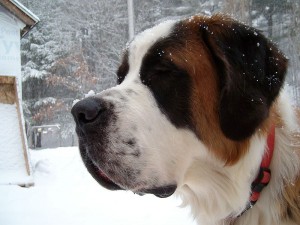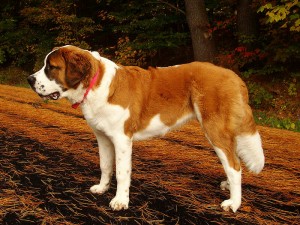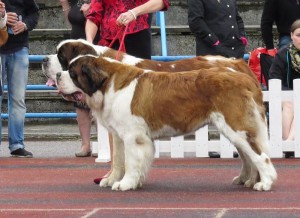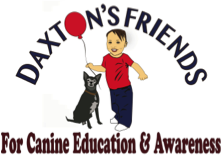 The Saint Bernard is basically a medieval sled-pulling dog, much like the Rottweiler descended from mastiff stock. It was used mostly in mountainous terrain. The breed is well known for their work in search and rescue in the Alps. When a traveler became lost, injured or missing a group of St. Bernard’s would be dispatched to search for them in the deep snows and passes between Switzerland and Italy. When the individual was located one dog would lay beside them to lick them and keep them warm. The other St. Bernard would return to the hospice and alert the dispatch for a rescue team. These canines occasionally do search and rescue work today, but most are bred as companion animals. The name St. Bernard derives from the Great St. Bernard Hospice, which is named after the St. Bernard Pass in the Western Alps. The breed, hospice, and the pass are all named after the monk Bernard of Methon. The earliest written mention of the St. Bernard is from 1707, but drawings with the dog date back even earlier.
The Saint Bernard is basically a medieval sled-pulling dog, much like the Rottweiler descended from mastiff stock. It was used mostly in mountainous terrain. The breed is well known for their work in search and rescue in the Alps. When a traveler became lost, injured or missing a group of St. Bernard’s would be dispatched to search for them in the deep snows and passes between Switzerland and Italy. When the individual was located one dog would lay beside them to lick them and keep them warm. The other St. Bernard would return to the hospice and alert the dispatch for a rescue team. These canines occasionally do search and rescue work today, but most are bred as companion animals. The name St. Bernard derives from the Great St. Bernard Hospice, which is named after the St. Bernard Pass in the Western Alps. The breed, hospice, and the pass are all named after the monk Bernard of Methon. The earliest written mention of the St. Bernard is from 1707, but drawings with the dog date back even earlier.
St. Bernard’s can be loyal and affectionate companions if they are properly socialized from a young age. They often start out as rambunctious and clumsy puppies, but grow more docile as they mature. Puppies require a great deal of exercise, while adults often prefer to relax or sleep. St. Bernard’s love the snow and will enjoy romping around and playing in it. The older and inactive St. Bernard must get proper exercise to keep fit and healthy.
 St. Bernard’s can be very difficult to train. They are stubborn and independent and only listen to commands when they choose to. They will often test boundaries and will try to get away with as much as they can. Owners must be firm and patient. They respond best to training involving rewards, such as treats. As they mature, they will often become more headstrong and difficult to control.
St. Bernard’s can be very difficult to train. They are stubborn and independent and only listen to commands when they choose to. They will often test boundaries and will try to get away with as much as they can. Owners must be firm and patient. They respond best to training involving rewards, such as treats. As they mature, they will often become more headstrong and difficult to control.
In recent years, due to popularity in the media and a higher demand for St. Bernards, breeders were not practicing discriminate breeding and the bloodlines became unpredictable. Some offspring began to display uneven temperaments and resultant behavior issues. It is important to view and observe parents before selecting a St, Bernard puppy to looks for signs of aggression in the litter.
St. Bernard’s are generally a messy breed. They are known for making quite a mess when they are eating or drinking. They drool and shed constantly; leaving trails of drool and fur everywhere they go. They are not recommended for households that place high importance cleanliness.
They can be weary of strangers and may bark at them. They tend to do well with children, but they can easily harm small children accidentally with their size. They are not guard dogs, but their presence may be an excellent deterrent against intruders.
 St. Bernards can have two types of coats. One is rough and longer in length while the other is shorter, smoother and dense. The longer coats of the St, Bernard require consistent brushing and do shed all year round. St. Bernard’s can often suffer from bone deterioration due to their fast growth, improper diet, and lack of exercise. They often can suffer from hip dysplasia, elbow dysplasia, Osteosarcoma, entropion, ectropion, epilepsy, and heart conditions. Typically they weigh between 140-260 lbs and live from 7-10 years.
St. Bernards can have two types of coats. One is rough and longer in length while the other is shorter, smoother and dense. The longer coats of the St, Bernard require consistent brushing and do shed all year round. St. Bernard’s can often suffer from bone deterioration due to their fast growth, improper diet, and lack of exercise. They often can suffer from hip dysplasia, elbow dysplasia, Osteosarcoma, entropion, ectropion, epilepsy, and heart conditions. Typically they weigh between 140-260 lbs and live from 7-10 years.

In 81 or 82 I was bitten in the throat by our st Bernard near fatal my name is Derek Stewart from wa state
I was walking up my street one day when I was young about 11. My mom had sent me to the store and I was walking in the street because the sidewalk was icy. Suddenly I was launch face first onto the road. Something was ripping at my back trying to I thought kill me. I don’t know how long I was being attacked when a neighbor pulled up and open his car door hitting the dog which stopped the attack. He took me home screaming in pain and terror. When my mother saw me she lost it. My thick heavy coat was in shreds I was covered in blood and slobber. She called the police and went to the ER. They cleaned me up gave me a shot and because our neighbor could describe the dog we knew the dog. They police knew the dog, because I was the fourth victim. Thankfully I did not need rabies shots. When the police finished they went to get the dog it had been deemed dangerous after the third attack and was to be euthanized but they said they didn’t have the dog. This time the because of the viciousness of the mauling the police went after the owner he got arrested. He brought the dog in and it was euthanized.
I’ve heard the term gentile giant to describe these dogs, if I didn’t have the heavy clothes and a neighbor I’d be dead….
I WANTED MY ST,BERNARD TO BE A SERVICE DOG,HE IS WELL MANNERED AND ALREADY 1 LEG SURGERY AND NEEDS ANOTHER,BUT LANDLORDS PUT THESE BIG GENTLE GIANTS IN A CATAGORY NOT TO INSURE AND SAY DANGEROUS,MINE LOVES TO BE PAT BY EVERYONE,AND HAS A CHAWAWAH AS HIS BEST FRIEND,WOULD HE BE A GOOD SERVICE DOG?HE IS 16 MONTHS AND VERY LOVEING,LIKES TO TALK,N HARDLY BARKS